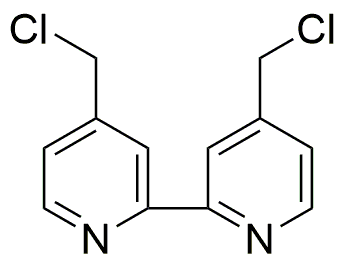4,4'-Bis(chloromethyl)-2,2'-bipyridyl is widely utilized in research focused on:
- Coordination Chemistry: This compound serves as a versatile ligand in coordination complexes, enhancing the stability and reactivity of metal ions, which is crucial for catalysis and material science.
- Organic Synthesis: It acts as an intermediate in the synthesis of various organic compounds, allowing chemists to create complex molecules with specific properties for pharmaceuticals and agrochemicals.
- Photovoltaic Applications: The compound is explored in the development of organic solar cells, where it contributes to improved light absorption and energy conversion efficiency.
- Biological Research: It is used in studies investigating the interactions between metal complexes and biological systems, aiding in drug development and understanding cellular processes.
- Polymer Chemistry: This chemical is incorporated into polymer matrices to enhance their properties, such as thermal stability and mechanical strength, making it valuable in materials engineering.
General Information
Properties
Safety and Regulations
Applications
4,4'-Bis(chloromethyl)-2,2'-bipyridyl is widely utilized in research focused on:
- Coordination Chemistry: This compound serves as a versatile ligand in coordination complexes, enhancing the stability and reactivity of metal ions, which is crucial for catalysis and material science.
- Organic Synthesis: It acts as an intermediate in the synthesis of various organic compounds, allowing chemists to create complex molecules with specific properties for pharmaceuticals and agrochemicals.
- Photovoltaic Applications: The compound is explored in the development of organic solar cells, where it contributes to improved light absorption and energy conversion efficiency.
- Biological Research: It is used in studies investigating the interactions between metal complexes and biological systems, aiding in drug development and understanding cellular processes.
- Polymer Chemistry: This chemical is incorporated into polymer matrices to enhance their properties, such as thermal stability and mechanical strength, making it valuable in materials engineering.
Documents
Safety Data Sheets (SDS)
The SDS provides comprehensive safety information on handling, storage, and disposal of the product.
Product Specification (PS)
The PS provides a comprehensive breakdown of the product’s properties, including chemical composition, physical state, purity, and storage requirements. It also details acceptable quality ranges and the product's intended applications.
Certificates of Analysis (COA)
Search for Certificates of Analysis (COA) by entering the products Lot Number. Lot and Batch Numbers can be found on a product’s label following the words ‘Lot’ or ‘Batch’.
*Catalog Number
*Lot Number
Certificates Of Origin (COO)
This COO confirms the country where the product was manufactured, and also details the materials and components used in it and whether it is derived from natural, synthetic, or other specific sources. This certificate may be required for customs, trade, and regulatory compliance.
*Catalog Number
*Lot Number
Safety Data Sheets (SDS)
The SDS provides comprehensive safety information on handling, storage, and disposal of the product.
DownloadProduct Specification (PS)
The PS provides a comprehensive breakdown of the product’s properties, including chemical composition, physical state, purity, and storage requirements. It also details acceptable quality ranges and the product's intended applications.
DownloadCertificates of Analysis (COA)
Search for Certificates of Analysis (COA) by entering the products Lot Number. Lot and Batch Numbers can be found on a product’s label following the words ‘Lot’ or ‘Batch’.
*Catalog Number
*Lot Number
Certificates Of Origin (COO)
This COO confirms the country where the product was manufactured, and also details the materials and components used in it and whether it is derived from natural, synthetic, or other specific sources. This certificate may be required for customs, trade, and regulatory compliance.


